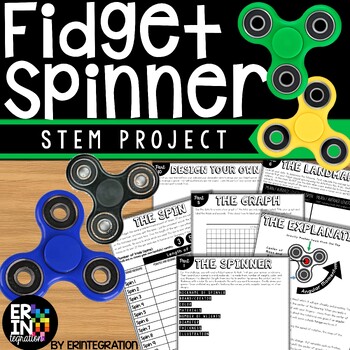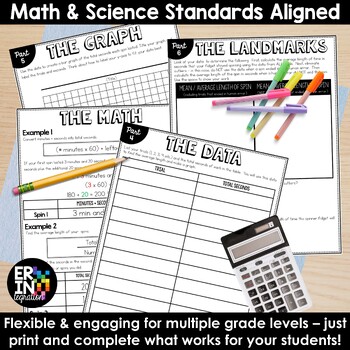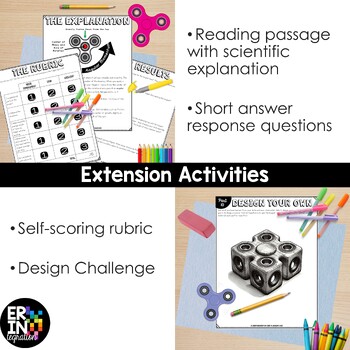Fidget Spinner STEM Challenge Activities and Science Experiment
Erintegration - Technology for Creative Teachers
13k Followers
Grade Levels
3rd - 6th
Subjects
Resource Type
Standards
CCSS3.MD.B.3
CCSS4.MD.A.2
CCSS5.MD.A.1
CCSS6.SP.B.5c
Formats Included
- PDF
Pages
25 pages
Erintegration - Technology for Creative Teachers
13k Followers
What educators are saying
Great resource. I used in a mixed group and I was able to target several different goals with one resource which is always a winner with me!
I used this resource when fidget spinners was a fad. My students had a lot of fun with the activity.
Description
The ORIGINAL Fidget Spinner Stem Challenge & Science Lab! Discover the science of fidget spinners with this engaging and low-prep STEM activity. Practice scientific method with an exploration of variables, data collection, graphing, mean/average, and more...all while having fun!
This self-paced, fidget spinner activity is print-and-go. Each activity sheet guides students through the project.
STEM Challenge Overview:
Students will use the included visual directions, graphic organizers, charts, and activities to...
- Describe and create a diagram of their fidget spinner.
- Check off variables and develop a technique for spinning.
- Record spin times then determine the average length of a spin of their spinner.
- Compare this to the class data to see which design styles and technique yield the longest spin time.
- Convert minutes and seconds into total seconds then graph total seconds
- Determine the average spin time of their spinner.
- Compare, record, and graph the average spin time with the class.
- Reflect on results with included conclusion questions.
- Use everything they have learned to design the ideal fidget spinner
Materials Needed:
- Students will need access to a fidget spinner either their own from home or you can purchase a set for the class. I suggest having at least 5 spinners so students can work in small groups and share the spinner.
- Device to record time - stop watch, kitchen timers, digital devices, etc.
Also Includes:
- Reading passage that explains the science behind the challenge.
- Cover page for challenge booklet
- Math examples to support all learners in converting minutes to seconds and finding the mean/average.
- Detailed teacher note page.
- Visual step-by-step directions to film a slow motion video on the iPad either with a free app or with iMovie (optional).
More STEM Challenges:
iPad and App Store are registered trademarks of Apple Inc. Erintegration is not affiliated with and has not been authorized, sponsored, or otherwise approved by Apple Inc.
Total Pages
25 pages
Answer Key
Rubric only
Teaching Duration
2 days
Report this resource to TPT
Reported resources will be reviewed by our team. Report this resource to let us know if this resource violates TPT’s content guidelines.
Standards
to see state-specific standards (only available in the US).
CCSS3.MD.B.3
Draw a scaled picture graph and a scaled bar graph to represent a data set with several categories. Solve one- and two-step “how many more” and “how many less” problems using information presented in scaled bar graphs. For example, draw a bar graph in which each square in the bar graph might represent 5 pets.
CCSS4.MD.A.2
Use the four operations to solve word problems involving distances, intervals of time, liquid volumes, masses of objects, and money, including problems involving simple fractions or decimals, and problems that require expressing measurements given in a larger unit in terms of a smaller unit. Represent measurement quantities using diagrams such as number line diagrams that feature a measurement scale.
CCSS5.MD.A.1
Convert among different-sized standard measurement units within a given measurement system (e.g., convert 5 cm to 0.05 m), and use these conversions in solving multi-step, real world problems.
CCSS6.SP.B.5c
Giving quantitative measures of center (median and/or mean) and variability (interquartile range and/or mean absolute deviation), as well as describing any overall pattern and any striking deviations from the overall pattern with reference to the context in which the data were gathered.





